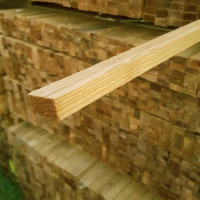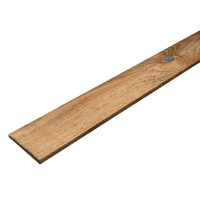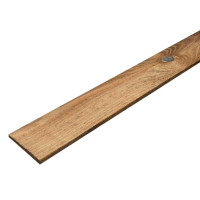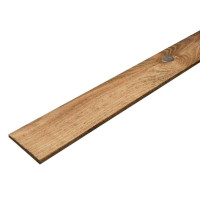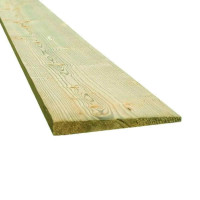Timber is an essential material for construction, landscaping, and various DIY projects. Its versatility, sustainability, and natural beauty make it a favourite choice for many. At East Coast Fencing, we provide a wide range of high-quality timber products to meet all your needs. Whether you're building a new deck, constructing a fence, or crafting custom furniture, our timber selection offers the perfect solution. Explore the different types of timber we offer and discover how they can be used in your next project.
Timber's strength and durability make it ideal for structural applications. Its natural resistance to weather conditions ensures longevity, even in outdoor settings. Additionally, timber's aesthetic appeal adds a touch of warmth and sophistication to any design. With proper treatment and maintenance, timber can last for decades, providing excellent value for money. Our timber products come from sustainably managed forests, ensuring that you are making an environmentally responsible choice.
One of the greatest benefits of timber is its ease of use. It can be easily cut, shaped, and assembled, making it suitable for both professionals and DIY enthusiasts. Timber's lightweight nature allows for easy transport and handling, reducing labour costs and effort. Furthermore, timber's versatility means it can be used in a wide range of applications, from basic framing to intricate joinery. With our premium timber products, you can achieve professional results with ease.
Another advantage of using timber is its insulating properties. Timber naturally regulates temperature and humidity, creating a comfortable and energy-efficient environment. This makes it an excellent choice for building homes, offices, and other structures. Timber also has sound-absorbing qualities, reducing noise levels and enhancing acoustic performance. By choosing timber, you can create spaces that are not only visually appealing but also comfortable and conducive to well-being.
In addition to its technical benefits, timber offers a timeless and classic aesthetic. Its natural grain patterns and warm tones add character and charm to any project. Timber can be stained, painted, or left in its natural state, allowing for endless design possibilities. Whether you prefer a rustic, traditional look or a sleek, modern finish, timber can be customised to suit your style. With our wide selection of timber products, you can bring your vision to life.
Feather Edge Boards
Feather edge boards are a popular choice for fencing and cladding applications. They are designed with one edge thinner than the other, allowing them to overlap neatly and create a sturdy, weather-resistant barrier. These boards are ideal for creating traditional closeboard fencing, providing privacy and security for your property. Our feather edge boards are pressure-treated for enhanced durability and protection against rot and insect damage.
Feather edge boards can be easily installed using timber posts and rails. The overlapping design ensures a tight fit, minimising gaps and preventing water ingress. This makes them suitable for use in all weather conditions. Additionally, feather edge boards can be painted or stained to match your existing décor, offering a versatile solution for both residential and commercial properties. With our high-quality feather edge boards, you can achieve a professional finish that stands the test of time.
In addition to fencing, feather edge boards can be used for cladding buildings and structures. Their robust construction provides excellent protection against the elements, while their attractive appearance enhances the overall aesthetic. Feather edge boards can be installed vertically or horizontally, depending on your design preference. They are also available in various lengths and thicknesses, allowing you to choose the perfect fit for your project.
Feather edge boards are an eco-friendly choice for your construction needs. They are made from sustainably sourced timber, ensuring minimal environmental impact. By choosing feather edge boards, you are supporting responsible forestry practices and contributing to the preservation of natural resources. Our feather edge boards are also recyclable and biodegradable, making them an environmentally responsible option.
When it comes to fencing and cladding, feather edge boards offer a cost-effective solution without compromising on quality. Their simple installation process and long-lasting performance make them a favourite among homeowners and contractors alike. With our wide range of feather edge boards, you can find the perfect match for your project and enjoy the benefits of a durable, attractive, and sustainable material.
Timber Battens
Timber battens are essential components in construction and landscaping projects. They are versatile, strong, and easy to work with, making them suitable for a wide range of applications. Timber battens are typically used as support structures for cladding, roofing, and flooring. Our timber battens are made from high-quality, sustainably sourced wood, ensuring durability and environmental responsibility.
One of the primary uses of timber battens is in roofing applications. They provide a solid framework for attaching roof tiles or shingles, ensuring stability and weather resistance. Timber battens are also used in wall cladding systems, where they act as a support for the cladding material. This creates a ventilated cavity that helps regulate temperature and moisture levels, improving the overall performance of the building envelope.
Timber battens are available in various sizes and profiles to suit different applications. They can be easily cut to length and fixed in place using nails or screws. Timber battens are also compatible with a range of cladding materials, including timber, metal, and composite panels. This versatility makes them an ideal choice for both new builds and renovation projects.
In addition to their structural uses, timber battens can be employed in landscaping projects. They are commonly used to create garden trellises, plant supports, and raised beds. Timber battens are also useful for constructing decking and pergolas, providing a sturdy framework for these outdoor features. Our timber battens are pressure-treated for enhanced durability and resistance to rot and insect damage.
Timber battens are an eco-friendly choice for your construction and landscaping needs. They are made from renewable resources and are recyclable at the end of their life. By choosing timber battens, you are supporting sustainable forestry practices and reducing your environmental impact. Our timber battens are also cost-effective, offering excellent value for money without compromising on quality.
C16 Construction Timber
C16 construction timber is a popular choice for structural applications due to its strength and durability. It is graded to meet specific performance standards, ensuring reliable and consistent quality. C16 construction timber is suitable for a wide range of building projects, including framing, flooring, and roofing. Our C16 construction timber is sourced from sustainably managed forests, providing an environmentally responsible option for your construction needs.
One of the key advantages of C16 construction timber is its high strength-to-weight ratio. This makes it ideal for use in load-bearing structures, where it provides excellent stability and support. C16 construction timber is also resistant to bending and warping, ensuring long-lasting performance. Additionally, it can be easily cut, drilled, and nailed, making it a versatile choice for both professionals and DIY enthusiasts.
C16 construction timber is treated with preservatives to protect against rot, decay, and insect damage. This enhances its durability and extends its lifespan, making it suitable for both indoor and outdoor applications. Our C16 construction timber is available in various sizes and lengths, allowing you to choose the perfect fit for your project. With its superior strength and durability, C16 construction timber is a reliable choice for any construction project.
In addition to its structural uses, C16 construction timber can be employed in a variety of other applications. It is commonly used for making garden furniture, decking, and pergolas, where its strength and resistance to weathering are particularly beneficial. C16 construction timber can also be used for creating bespoke joinery and cabinetry, providing a strong and stable material for these projects.
C16 construction timber is an eco-friendly choice for your building needs. It is sourced from sustainably managed forests, ensuring minimal environmental impact. By choosing C16 construction timber, you are supporting responsible forestry practices and contributing to the preservation of natural resources. Our C16 construction timber is also recyclable and biodegradable, making it an environmentally responsible option.
When it comes to construction projects, C16 construction timber offers a cost-effective solution without compromising on quality. Its high strength and durability make it an ideal choice for a wide range of applications, from structural framing to outdoor furniture. With our premium C16 construction timber, you can achieve professional results and enjoy the benefits of a strong, reliable, and sustainable material.
Square Rails
Square rails are versatile and practical components for a variety of construction and landscaping projects. They are typically used for creating fences, gates, and balustrades, providing a sturdy and attractive framework. Our square rails are made from high-quality timber, ensuring durability and a smooth finish. Available in various sizes and lengths, our square rails offer a flexible solution for your building needs.
One of the primary uses of square rails is in fencing applications. They provide a solid framework for attaching fence panels, pickets, or wire mesh, ensuring stability and strength. Square rails can be easily cut to length and fixed in place using nails or screws. Their smooth surface and uniform dimensions make them easy to work with, allowing for precise and professional results.
Square rails are also ideal for creating gates and balustrades. Their robust construction provides excellent support for these structures, ensuring safety and durability. Square rails can be painted or stained to match your existing décor, offering a versatile solution for both residential and commercial properties. With our high-quality square rails, you can create attractive and functional outdoor features that stand the test of time.
In addition to their structural uses, square rails can be employed in a variety of other applications. They are commonly used for making garden furniture, raised beds, and planters, where their strength and resistance to weathering are particularly beneficial. Square rails can also be used for creating bespoke joinery and cabinetry, providing a strong and stable material for these projects.
Square rails are an eco-friendly choice for your construction and landscaping needs. They are made from sustainably sourced timber, ensuring minimal environmental impact. By choosing square rails, you are supporting responsible forestry practices and contributing to the preservation of natural resources. Our square rails are also recyclable and biodegradable, making them an environmentally responsible option.
When it comes to construction projects, square rails offer a cost-effective solution without compromising on quality. Their simple installation process and long-lasting performance make them a favourite among homeowners and contractors alike. With our wide range of square rails, you can find the perfect match for your project and enjoy the benefits of a durable, attractive, and sustainable material.
Picket Pales
Picket pales are a classic choice for creating attractive and functional fences. They are designed with a pointed top, adding a touch of charm and character to any property. Picket pales are ideal for creating traditional picket fences, providing a decorative and secure barrier. Our picket pales are made from high-quality timber, ensuring durability and a smooth finish.
One of the primary uses of picket pales is in fencing applications. They provide a solid framework for attaching fence panels, pickets, or wire mesh, ensuring stability and strength. Picket pales can be easily cut to length and fixed in place using nails or screws. Their smooth surface and uniform dimensions make them easy to work with, allowing for precise and professional results.
Picket pales are also ideal for creating gates and balustrades. Their robust construction provides excellent support for these structures, ensuring safety and durability. Picket pales can be painted or stained to match your existing décor, offering a versatile solution for both residential and commercial properties. With our high-quality picket pales, you can create attractive and functional outdoor features that stand the test of time.
In addition to their structural uses, picket pales can be employed in a variety of other applications. They are commonly used for making garden furniture, raised beds, and planters, where their strength and resistance to weathering are particularly beneficial. Picket pales can also be used for creating bespoke joinery and cabinetry, providing a strong and stable material for these projects.
Picket pales are an eco-friendly choice for your construction and landscaping needs. They are made from sustainably sourced timber, ensuring minimal environmental impact. By choosing picket pales, you are supporting responsible forestry practices and contributing to the preservation of natural resources. Our picket pales are also recyclable and biodegradable, making them an environmentally responsible option.
When it comes to construction projects, picket pales offer a cost-effective solution without compromising on quality. Their simple installation process and long-lasting performance make them a favourite among homeowners and contractors alike. With our wide range of picket pales, you can find the perfect match for your project and enjoy the benefits of a durable, attractive, and sustainable material.
Cant Rails
Cant rails are essential components for creating robust and durable fencing systems. They are designed with a chamfered edge, allowing for a neat and secure fit with fence panels or boards. Cant rails provide excellent support and stability for fencing structures, ensuring long-lasting performance. Our cant rails are made from high-quality timber, ensuring durability and a smooth finish.
One of the primary uses of cant rails is in fencing applications. They provide a solid framework for attaching fence panels, pickets, or wire mesh, ensuring stability and strength. Cant rails can be easily cut to length and fixed in place using nails or screws. Their smooth surface and uniform dimensions make them easy to work with, allowing for precise and professional results.
Cant rails are also ideal for creating gates and balustrades. Their robust construction provides excellent support for these structures, ensuring safety and durability. Cant rails can be painted or stained to match your existing décor, offering a versatile solution for both residential and commercial properties. With our high-quality cant rails, you can create attractive and functional outdoor features that stand the test of time.
In addition to their structural uses, cant rails can be employed in a variety of other applications. They are commonly used for making garden furniture, raised beds, and planters, where their strength and resistance to weathering are particularly beneficial. Cant rails can also be used for creating bespoke joinery and cabinetry, providing a strong and stable material for these projects.
Cant rails are an eco-friendly choice for your construction and landscaping needs. They are made from sustainably sourced timber, ensuring minimal environmental impact. By choosing cant rails, you are supporting responsible forestry practices and contributing to the preservation of natural resources. Our cant rails are also recyclable and biodegradable, making them an environmentally responsible option.
When it comes to construction projects, cant rails offer a cost-effective solution without compromising on quality. Their simple installation process and long-lasting performance make them a favourite among homeowners and contractors alike. With our wide range of cant rails, you can find the perfect match for your project and enjoy the benefits of a durable, attractive, and sustainable material.
Panel Capping
Panel capping is an essential component for creating neat and finished fencing systems. It is designed to fit on top of fence panels, providing a protective and decorative edge. Panel capping enhances the overall appearance of your fence while protecting it from weathering and damage. Our panel capping is made from high-quality timber, ensuring durability and a smooth finish.
One of the primary uses of panel capping is in fencing applications. It provides a neat and secure edge for fence panels, ensuring stability and protection. Panel capping can be easily cut to length and fixed in place using nails or screws. Its smooth surface and uniform dimensions make it easy to work with, allowing for precise and professional results.
Panel capping is also ideal for creating gates and balustrades. Its robust construction provides excellent support for these structures, ensuring safety and durability. Panel capping can be painted or stained to match your existing décor, offering a versatile solution for both residential and commercial properties. With our high-quality panel capping, you can create attractive and functional outdoor features that stand the test of time.
In addition to its structural uses, panel capping can be employed in a variety of other applications. It is commonly used for making garden furniture, raised beds, and planters, where its strength and resistance to weathering are particularly beneficial. Panel capping can also be used for creating bespoke joinery and cabinetry, providing a strong and stable material for these projects.
Panel capping is an eco-friendly choice for your construction and landscaping needs. It is made from sustainably sourced timber, ensuring minimal environmental impact. By choosing panel capping, you are supporting responsible forestry practices and contributing to the preservation of natural resources. Our panel capping is also recyclable and biodegradable, making it an environmentally responsible option.
When it comes to construction projects, panel capping offers a cost-effective solution without compromising on quality. Its simple installation process and long-lasting performance make it a favourite among homeowners and contractors alike. With our wide range of panel capping, you can find the perfect match for your project and enjoy the benefits of a durable, attractive, and sustainable material.
Half Round Rails
Half round rails are versatile and practical components for a variety of construction and landscaping projects. They are typically used for creating fences, gates, and balustrades, providing a sturdy and attractive framework. Our half round rails are made from high-quality timber, ensuring durability and a smooth finish. Available in various sizes and lengths, our half round rails offer a flexible solution for your building needs.
One of the primary uses of half round rails is in fencing applications. They provide a solid framework for attaching fence panels, pickets, or wire mesh, ensuring stability and strength. Half round rails can be easily cut to length and fixed in place using nails or screws. Their smooth surface and uniform dimensions make them easy to work with, allowing for precise and professional results.
Half round rails are also ideal for creating gates and balustrades. Their robust construction provides excellent support for these structures, ensuring safety and durability. Half round rails can be painted or stained to match your existing décor, offering a versatile solution for both residential and commercial properties. With our high-quality half round rails, you can create attractive and functional outdoor features that stand the test of time.
In addition to their structural uses, half round rails can be employed in a variety of other applications. They are commonly used for making garden furniture, raised beds, and planters, where their strength and resistance to weathering are particularly beneficial. Half round rails can also be used for creating bespoke joinery and cabinetry, providing a strong and stable material for these projects.
Half round rails are an eco-friendly choice for your construction and landscaping needs. They are made from sustainably sourced timber, ensuring minimal environmental impact. By choosing half round rails, you are supporting responsible forestry practices and contributing to the preservation of natural resources. Our half round rails are also recyclable and biodegradable, making them an environmentally responsible option.
When it comes to construction projects, half round rails offer a cost-effective solution without compromising on quality. Their simple installation process and long-lasting performance make them a favourite among homeowners and contractors alike. With our wide range of half round rails, you can find the perfect match for your project and enjoy the benefits of a durable, attractive, and sustainable material.
Timber Delivered
Our delivery service covers Bedfordshire, Berkshire, Buckinghamshire, Cambridgeshire, East Sussex, Essex, Greater London, Hertfordshire, Kent, Norfolk, Northamptonshire, Oxfordshire, Suffolk, Surrey, and West Sussex.



